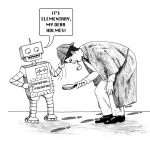In 2010 I was invited to write a glossy brochure for a committee of the National Academy of Sciences called “Mathematics in the Year 2025.” The committee was charged with making recommendations for government support of mathematics over the next decade or so. My job was to write a brochure that would highlight some of the success stories of mathematics over the past decade.
I’m glad to announce that the 57-page brochure, entitled Fueling Innovation and Discovery, has finally been published. You can download the PDF for free from the National Academy website. Or if you prefer a hard copy, you can buy it for $19.95.
The great majority of the brochure is devoted to eleven “vignettes” that run the gamut from (somewhat) pure mathematics to statistics to computational science. The topics include compressed sensing (a way of getting high-quality images from sparse data), mathematical simulations (such as supercomputer simulations of protein folding), Bayesian inference (a statistical method used, for instance, in spam detection and in the search for breast cancer genes), and Schramm-Loewner evolution (a model that enables precise predictions about processes in statistical physics, such as Brownian motion). That’s just four of them; there are seven more!
Among with these two- to three-page vignettes I also wrote some shorter mini-vignettes called “Mathematical Sciences Inside…” (The reference to the old “Intel Inside” commercials was intentional.) My favorite one of these is called “Mathematical Sciences Inside… Inventions.” I picked out ten mathematical ideas that have been cited inside recent patents: for example, the Viterbi algorithm (used in cell phones, CD and DVD players) and quaternions (used for a self-orienting toothbrush that, to my knowledge, is not on the market yet). It was great fun to see what mathematics really gets applied, and how. It isn’t necessarily the kind of math you learned in school! (The Viterbi algorithm, for example, is mentioned in thousands of patents. Raise your hand if you’ve heard of it.)
As with the SIAM Mathematics in Industry report that I co-authored, you won’t find my name on this one. That’s contract work for you! But the relative lack of recognition is not a very big issue for me. As I like to tell my wife, “How many times do you get asked to write something for your country?”



